Rule 3h when building a startup team Preply
My name is Cyril and I am a co-founder of the startup Preply.com. Preply is a classic marketplace for local and Skype tutors in English. In this introductory article I would like to talk about the Preply team. She changed her composition several times and as a whole, we made a sufficient number of mistakes until we came to its modern look. Now our team can be described by a simple rule "3h". The rule is used when building a startup team and says that co-founders should have three types of functions and characters: Hacker, Hipster and Hustler.

You probably already guessed what each of them has a task, but let me tell you in more detail on my own experience. The Hacker is a master of code and it’s important that such a person be a practitioner who knows how to build real things. The Hipster is your design ninja, he must have good UI and UX skills to make the product not only beautiful and cute, but also convenient to use. The last guy, The Hustler, should know how to sell things, this man is a speaker, a seller of dreams.
')
According to the functional directions, the situation is clear, but what about the types of characters? The same 3h approach works here. The Hacker is a man who thinks about how to get around an established system. The Hipster approaches every task creatively. The Hustler shouts “forward” all the time and motivates to move.
Let's now look at a little more detail with examples from the startup Preply. We have three co-founders in our team: Dmitry, Sergey and me. In our case, the functional and mental types coincided.
Our service station Dmitriy is a multilingual developer who understands architecture and works with both frontend and backend. In addition, he has a good background in Internet marketing and PR.

Dmitry will tell about examples of our decisions himself:
“Developing Preply.com is an exciting experience. Since the project is quite marketing, most of the work is at the intersection of programming and marketing. We do not have a single “rocket science” technology in the project, on which everything rests and which is the key to the success of the project, but there are many interesting “bricks” that together build up a rather interesting architecture. I will cite a few examples where the right integration of marketing into programming together gives a tangible business result:
In the role of hipster we have Sergey. Its tasks include what is usually described in terms of User Experience and User Interface.

A few examples of how his work is organized:
I do customer support, marketing and finance. I have to be able to correctly sell the product and idea to everyone: users, the press, investors and my team. The hustler’s responsibilities also include maintaining morale, productivity and team motivation. I am very lucky that both Dima and Sergey share this burden with me.

What characteristic tasks can be encountered:
Building a good team is not an easy process and you should pay attention to many factors. I would single out the 3h rule, which distributes functions well among the co-founders. My favorite example is the airbnb command. Brian Chesky as a hustler, Nathan Blecharczyk as a hacker and Joe Gebbia as a designer.
I would also add that each of the co-founders should be a T-shape specialist, i.e. have one key expertise and a number of auxiliary ones. On the example of Preply, it is clearly seen that the ability to close tasks related to the main activity helped us a lot. So Sergey here closes the entire front of work on User Experience, starting from prototyping and ending with the texts and style of communication with clients. Dmitry closes all development and does many marketing tasks, some of which include the need for programming. These are analytics, contextual advertising, affiliate programs, social integration and a number of other growthhacks. I, in turn, close the communication with customers and investors, a number of areas of marketing, including SEO, PR and SMM and content marketing workflow management.
Additionally, I would note the speed of obtaining new knowledge and skills. We had to learn a lot during the construction of Preply and, I am sure, even more will have to learn in the future. The ability to quickly learn is important not only for co-founders, but also for subsequent employees in a modern, rapidly changing business environment.
What do you think about rule 3h and building the perfect team?

You probably already guessed what each of them has a task, but let me tell you in more detail on my own experience. The Hacker is a master of code and it’s important that such a person be a practitioner who knows how to build real things. The Hipster is your design ninja, he must have good UI and UX skills to make the product not only beautiful and cute, but also convenient to use. The last guy, The Hustler, should know how to sell things, this man is a speaker, a seller of dreams.
')
According to the functional directions, the situation is clear, but what about the types of characters? The same 3h approach works here. The Hacker is a man who thinks about how to get around an established system. The Hipster approaches every task creatively. The Hustler shouts “forward” all the time and motivates to move.
Let's now look at a little more detail with examples from the startup Preply. We have three co-founders in our team: Dmitry, Sergey and me. In our case, the functional and mental types coincided.
The hacker
Our service station Dmitriy is a multilingual developer who understands architecture and works with both frontend and backend. In addition, he has a good background in Internet marketing and PR.

Dmitry will tell about examples of our decisions himself:
“Developing Preply.com is an exciting experience. Since the project is quite marketing, most of the work is at the intersection of programming and marketing. We do not have a single “rocket science” technology in the project, on which everything rests and which is the key to the success of the project, but there are many interesting “bricks” that together build up a rather interesting architecture. I will cite a few examples where the right integration of marketing into programming together gives a tangible business result:
- At the very beginning of development, we saw the potential in affiliate programs in the format of "white label" or branded widgets. Using Django-tastypie in conjunction with Backbone to develop an API, we have developed an architecture from the very beginning for easy integration of third-party services through our API. Our affiliate programs bring us 4% of traffic now and the percentage of traffic from this channel will grow.
- A deep digging in Google Analytics and Yandex.Metrica in the first months of the project gave us insight that giving tutors is the main factor that influences the conversion. The user has more than 10 different filters. The extent to which the relevant result is given by the system directly affects whether it leaves a request. Therefore, it was necessary to write your little "Google", which sorts tutors. Now it is based on more than 30 parameters: response speed, profile fullness, query matching and filters, reviews, tutor conversion, profile CTR, etc. The output is generated in real time mode, memcached is cached, ratings are recalculated asynchronously via RabbitMq + Celery. The result - the conversion is growing from month to month.
- The last thing I can remember right away is a scientific approach to the tasks. One of the problems we face is the user's desire to deceive us and exchange contacts with the tutor through the internal messages of the site. At first, we blocked such attempts manually, but as traffic grew, we had to write a simple Machine Learning system based on the Machine Learning course of Professor Andrew Ng (Coursera). The system rather accurately identifies the violators of the rules and automatically blocks them. Thus, we have more than 2 (!) Times increased the conversion of applications in the payment. "
The hipster
In the role of hipster we have Sergey. Its tasks include what is usually described in terms of User Experience and User Interface.

A few examples of how his work is organized:
- It so happened that in our team, most of the texts for the site are written or edited by the designer. This approach gives the designer more freedom and shortens the development chain - we don’t have to involve a copywriter in the process. At the same time, it is necessary to develop in such areas as informational editing and copywriting.
- When planning key changes on the site, we always start by analyzing the data that was collected using Crazy Egg, Google Analytics, Yandex Metrics. This helps us to understand the objectives of the design and first of all focus on their achievement.
- If we talk about the early stages of product development, the work began with design. We used the key principles of the methodology described by Alan Cooper: created characters, their main product use scenarios, then designed prototypes using Axure and tested them on potential users.
The hustler
I do customer support, marketing and finance. I have to be able to correctly sell the product and idea to everyone: users, the press, investors and my team. The hustler’s responsibilities also include maintaining morale, productivity and team motivation. I am very lucky that both Dima and Sergey share this burden with me.

What characteristic tasks can be encountered:
- Attracting investment. In fact, this is a specific sales process, i.e. you build a funnel from lead to deal and start working with it. Naturally, you need to be well prepared:
- choose the most suitable investors for you;
- find people who can do an intro to these investors;
- build your business model and business model of competitors;
- highlight key financial indicators;
- design their growth;
- All information about the company and all the research should be put on paper and issued in the executive summary and pitch deck.
- We started to build the marketplace with the simplest one - we made landing page with an application form and started driving targeted traffic there. I processed each request manually by means of calls. So in a fairly short period of time I managed to make a high-quality customer development. Based on the information collected, we built a platform.
- For us, one of the channels to attract users is search engine optimization. I had to master the knowledge in this direction in a relatively short period of time. Recently, only a year has passed, as I have been doing SEO, and during this time I have already thoroughly familiarized myself with all the key promotion factors in both Google and Yandex. Now our positions are constantly growing.
The main conclusions from the experience of building the Preply team:
Building a good team is not an easy process and you should pay attention to many factors. I would single out the 3h rule, which distributes functions well among the co-founders. My favorite example is the airbnb command. Brian Chesky as a hustler, Nathan Blecharczyk as a hacker and Joe Gebbia as a designer.
I would also add that each of the co-founders should be a T-shape specialist, i.e. have one key expertise and a number of auxiliary ones. On the example of Preply, it is clearly seen that the ability to close tasks related to the main activity helped us a lot. So Sergey here closes the entire front of work on User Experience, starting from prototyping and ending with the texts and style of communication with clients. Dmitry closes all development and does many marketing tasks, some of which include the need for programming. These are analytics, contextual advertising, affiliate programs, social integration and a number of other growthhacks. I, in turn, close the communication with customers and investors, a number of areas of marketing, including SEO, PR and SMM and content marketing workflow management.
Additionally, I would note the speed of obtaining new knowledge and skills. We had to learn a lot during the construction of Preply and, I am sure, even more will have to learn in the future. The ability to quickly learn is important not only for co-founders, but also for subsequent employees in a modern, rapidly changing business environment.
What do you think about rule 3h and building the perfect team?
Source: https://habr.com/ru/post/210452/
All Articles